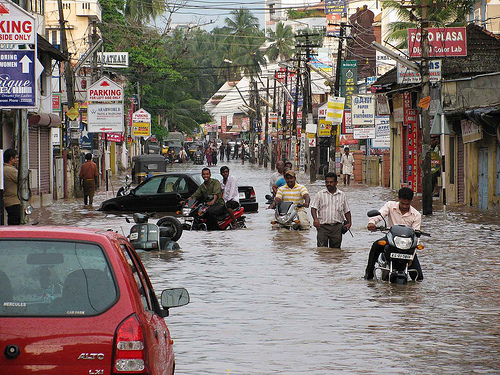Floods are categorized into natural and artificial floods in terms of their causes. Floods are natural hydrological phenomena and occur after some meteorological events like intense or prolonged rainfall spells or unusually high coastal estuarine waters due to storm surges etc.

Types of floods
- River flooding: River flooding occurs when heavy rains or rapid snow-melt cause rivers to rise.
- Coastal flooding: Coastal flooding may occur due to tidal surges and flash flooding.
- Flash floods: Flash floods usually result from intense storms which release large amounts of rain within a brief period.
- Dam failure: Dam failures are potentially the worst flood events. When a dam fails, a gigantic quantity of water is suddenly let loose downstream, destroying anything in its path.
Urban area flooding can be caused by flash floods, coastal floods or river floods.
What causes Urban flooding?
Urban flooding is caused due to lack of drainage facilities and other defects in engineering works such as defects in canals in urban areas. High intensity rains can cause urban flooding since urban areas have a lot of concrete structures and there isn’t much open soil available for water to percolate, causing a huge burden on the drainage systems of our cities.
In many cities, the drainage systems are not efficient enough to drain the rain water completely. Water may even get drained from one part of the city in order for it to be deposited in another part of the city. When the city has a flat terrain, the flow of water is slow.
A significant factor for high intensity rains in urban areas ultimately leading to urban flooding is the urban heat island effect, where cities are warmer than their surroundings which causes the buildup of rain clouds on the city. Pollution allows the rain to coalesce around dust and oil particles and the wind break effect causes the clouds to discharge on the cities.
Effects of urban flooding
These floods are of great disturbance to the city’s daily routine. It leads to traffic disruptions and inconvenience for pedestrians caused by puddles of water at building entrances, on sidewalks and parking spaces. The roads get blocked and people cannot travel to work. There is damage to city infrastructure. But the number of causalities is very less due to the nature of the floods.
Some precautionary steps one should take
- Follow the weather forecast and advisories from authorities during rainy season/monsoon.
- Be aware of all your surroundings.
- If you are staying in low lying areas move to higher ground in case water enters your locality.
Some do’s if stuck in urban floods
- If you have to walk in standing water, use a pole or stick to ensure that you do not step into deep water, open manholes or ditches.
- If flood waters rise around your car, abandon the car and move to higher ground if you can do so safely. You and the vehicle can be quickly swept away.
- Look before you step - after a flood, the ground and floors are covered with debris, which may include broken bottles, sharp objects, nails etc. Floors and stairs covered with mud and debris can be slippery.
- Switch off all electrical and gas appliances, and turn services off at the mains.
- Keep essential medicines, battery operated torch, dry clothes, some food and drinking water ready. Do your research on what is essential in case of emergency.
- Be alert for gas leaks - do not smoke or use candles, lanterns, or open flames.
- Always inform your family of your whereabouts as communication lines may be disrupted.
Some don’ts if stuck in urban floods
- Don't swim through fast flowing water - you may get swept away or struck by an object in the water.
- Don’t venture near power lines - electrical current can travel through water.
- Don’t touch electrical equipment if you are standing in water.
- Avoid contact with flood water - it may be contaminated with sewage, oil, chemicals and other harmful substances.
- Don’t return to your property until the “All Clear” message has been given by the local authorities.
- Don’t reconnect your power supply until a qualified engineer has checked it.
- Don't walk through flowing water - currents can be deceptive, and shallow, fast moving water can knock you off your feet and drown you.
- Don’t eat any food that has come into contact with flood water.
References
http://www.floodsite.net/juniorfloodsite/html/en/student/thingstoknow/hydrology/urbanfloods.html
http://wiki.answers.com/Q/What_is_a_urban_flood
http://www.iwawaterwiki.org/xwiki/bin/view/Articles/FloodTypesInundationTypes
http://rainwaterharvesting.wordpress.com/2008/09/06/urban-floods-in-bengaluru/
/articles/basic-guidelines-about-floods-causes-consequences-precautionary-steps-and-some-dos-and